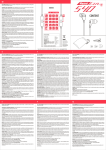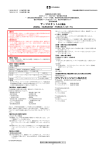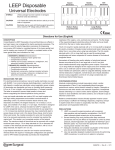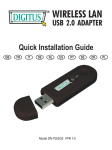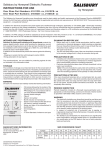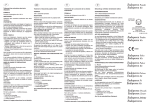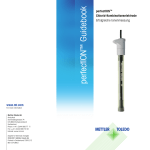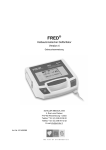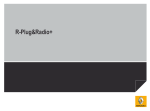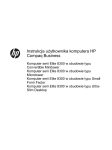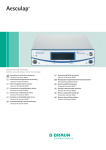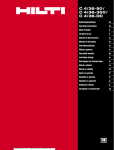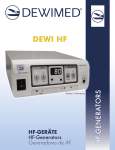Download GEBRAUCHSANWEISUNG Neutralelektrode 815-040
Transcript
MN031-517-S0 10/12 DE GEBRAUCHSANWEISUNG Neutralelektrode 815-040, 815-070, 815-110, 815-140, 816-042, 816-071, 816-072, 816-112, 816141, 816-161, 816-162, 817-040, 817-070, 817-110, 817-140, 818-042, 818-071, 818-072, 818-112, 818-141, 818-161, 818-162 Richtlinie Medizinprodukte Die Produkte tragen das CE Zeichen nach Richtlinie 93 / 42 / EWG und sind konform mit DIN EN ISO 10993 und IEC 60601-2-2. 0123 1. Bestimmungsgemäßer Gebrauch Einweg-Neutralelektroden sind selbstklebende, gebrauchsfertige Einwegprodukte und stellen ein Zubehör der HF-Chirurgie bei monopolarer Anwendung dar. Die Elektroden dienen dazu, den Stromkreis zwischen Patient und HF-Generator auf der passiven Seite zu schließen. 2. Allgemeine Sicherheitshinweise Die Neutralelektroden dürfen nur durch ausgebildetes medizinisches Fachpersonal angewendet werden. Der Chirurg und das medizinische Fachpersonal müssen in Grundlagen, Anwendungsregeln und Risiken der HFChirurgie geschult und damit vertraut sein. Beachten Sie die Bedienungshinweise des verwendeten HF-Generators. Beachten Sie die Bedienungshinweise auf der Verpackung der Neutralelektrode. Beachten Sie das Verfallsdatum auf der Verpackung der Neutralelektrode. Verwenden Sie nur Neutralelektroden, die mit Ihrem HF-Generator kompatibel sind. Beachten Sie hierzu die Kompatibilitätsliste. Beachten Sie mögliche Leistungsbegrenzungen der Neutralelektrode bei der Einstellung am HF-Generator. Überzeugen Sie sich vor der Applikation vom einwandfreien Zustand der Neutralelektrode. Stellen Sie sicher, dass am Neutralelektroden-Anschluss kein Kurzschluss entstehen kann. Die Neutralelektroden sind gebrauchsfertig: Verwenden Sie kein zusätzliches Kontaktgel. Die Neutralelektroden sind keine Sterilprodukte und dürfen nicht sterilisiert werden. Jede Veränderung der Neutralelektrode (z.B. Zuschneiden) führt zum Ausschluss der Haftung des Herstellers. 3. Auswahl der Elektrode Beachten Sie folgende Anwendungsbereiche der Neutralelektrode: Darstellung Anwendungsbereich REF ohne Kabel REF mit Kabel Universalelektroden für Patienten mit einem Körpergewicht von > 5 kg (Erwachsene und Kinder) 816-072, 816-112, 815-110 818-072, 818-112, 817-110 Elektroden für Patienten mit einem Körpergewicht von > 15 kg (Erwachsene) 816-162, 816-161, 816-141, 815-140 818-162, 818-161, 818-141, 817-140 Elektroden für Patienten mit einem Körpergewicht von 5 – 15 kg (Kinder) 816-071, 815-070 818-071, 817-070 Elektroden für Patienten mit einem Körpergewicht von < 5 kg (Neugeborene) 816-042, 815-040 818-042, 817-040 Geteilte Neutralelektroden Falls Ihr HF-Gerät eine Kontakt-Qualitäts-Überwachungsschaltung (CQM, z.B.: "EASY", "REM", "NESSY") besitzt, stets geteilte Neutralelektroden verwenden. Bei Verwendung von geteilten Neutralelektroden mit einem CQM-System wird der Kontakt zum Patienten automatisch überwacht. Einteilige Neutralelektroden Bei HF-Geräten ohne CQM-System und bei Verwendung von einteiligen Neutralelektroden wird der Kontakt zum Patienten nicht überwacht. Prüfen Sie regelmäßig und nach dem Umlagern des Patienten die vollflächige Anlage der Neutralelektrode. Eine teilweise abgezogene Neutralelektrode kann zu Hautschädigungen führen. BOWA-electronic GmbH & Co. KG Heinrich-Hertz-Str. 4-10 72810 Gomaringen/Germany Tel. (+49) 7072-6002-0 Fax (+49) 7072-6002-33 [email protected] www.bowa-medical.com 4. Applikationshinweise Geeignete Applikationsstelle: Wählen Sie die Applikationsstelle der Neutralelektrode so, dass die Stromwege zwischen Aktiv- und Neutralelektrode so kurz wie möglich sind und in Längs- oder Diagonalrichtung zum Körper verlaufen, da Muskeln in Richtung der Fibrillen eine höhere Leitfähigkeit besitzen. Applizieren Sie in Abhängigkeit vom Operationsfeld die Neutralelektrode möglichst am nächstgelegenen Oberarm oder Oberschenkel, jedoch nicht näher als 20 cm. Die Neutralelektrode muss am liegenden Patienten auf der Oberseite des Körpers positioniert sein, um Unterwaschung vorzubeugen. Die Applikationsstelle muss trocken sein. Gegebenenfalls verwendete Reinigungsmittel vollständig abtrocknen lassen. Kontraindikation Die Neutralelektrode darf nicht auf geschädigter oder verletzter Haut angebracht werden. Patientenvorbereitung: Entfernen Sie den Metallschmuck. Entfernen Sie starken Haarwuchs. Reinigen Sie die Applikationsstelle und verwenden Sie keinen Alkohol, da dieser die Haut austrocknet und den Übergangswiderstand erhöht. Massieren oder bürsten Sie bei schlechter Durchblutung die Applikationsstelle. Elektrodenvorbereitung: Die Neutralelektrode ist vor dem Gebrauch auf Beschädigungen zu prüfen. Bei Beschädigung darf die Neutralelektrode nicht mehr verwendet werden. Ziehen Sie die Schutzfolie ab. Applikation: Kleben Sie die Neutralelektrode auf. Stellen Sie dabei sicher, dass die Neutralelektrode mit der längeren Kante zum Operationsgebiet vollflächigen Hautkontakt hat. Eine Überhöhung der Stromdichte an der kurzen Kante wird dadurch vermieden. Vermeiden Sie die Applikation auf massivem Unterhautfettgewebe. Sorgen Sie dafür, dass die Applikationsstelle frei von Narbengewebe, Knochenvorsprüngen und behaarten Stellen und ist. Achten Sie darauf, dass keine EKG-Elektroden oder Implantate (z. B. Knochennägel, Knochenplatten, Endoprothesen) im Stromweg liegen. Vermeiden Sie Stellen, an denen sich Flüssigkeiten ansammeln können. Vermeiden Sie die Positionierung der Neutralelektrode unter Gesäß oder Rücken des Patienten. Verlegen Sie bei Operationen im Bereich des Thorax den Stromweg nicht quer und achten Sie darauf, dass das Herz niemals im Stromweg liegt. Kontaktierung: Streichen Sie die Neutralelektrode auf dem Körper des Patienten fest an. Achten Sie darauf, dass die Neutralelektrode ganzflächig und faltenfrei aufgebracht wird, um Luftblasen unter der Neutralelektrode zu vermeiden. Achten Sie darauf, dass der Schutzrand vollständig und faltenfrei am Patienten klebt. BOWA-electronic GmbH & Co. KG Heinrich-Hertz-Str. 4-10 72810 Gomaringen/Germany Tel. (+49) 7072-6002-0 Fax (+49) 7072-6002-33 [email protected] www.bowa-medical.com 5. Platzierung des Kabels Kabel nicht um einen Arm, ein Bein oder ein Metallobjekt herumführen oder herumwickeln. Kabel nicht auf oder unter dem Patienten verlaufen lassen. Keine Kabelklemmen unter dem Patienten platzieren. 6. Entfernen der Neutralelektrode Abziehen der Elektrode: Elektrodenkabel grundsätzlich am Stecker abziehen. Entfernen Sie die Neutralelektrode nach Gebrauch vorsichtig von einer Ecke aus. Ein zu rasches Abziehen der Neutralelektrode kann Hautreizungen (Rötungen) hervorrufen. Einmalverwendung: Neutralelektroden sind ausschließlich für den einmaligen Gebrauch bestimmt. Eine falsch applizierte Neutralelektrode nicht erneut aufbringen. Eine Wiederverwendung stellt durch möglicherweise eingeschränkte Leistungsmerkmale der Neutralelektrode eine Gefährdung des Patienten in Form von HF-Verbrennungen dar. Entsorgung: Neutralelektrode nach Gebrauch entsorgen. Die Entsorgung der Medizinprodukte, des Verpackungsmaterials sowie des Zubehörs muss nach den jeweils geltenden länderspezifischen Vorschriften und Gesetzen erfolgen. 7. Lagerung Öffnen der Verpackungsbeutel erst unmittelbar vor Gebrauch. Neutralelektroden sind im geöffneten Verpackungsbeutel maximal 7 Tage haltbar. Lagern Sie die Neutralelektroden in der Originalverpackung an einem trockenen Ort. Vermeiden Sie direkte Sonneneinstrahlung und Nähe zu Wärmequellen. Die zulässige Lagertemperatur liegt im Bereich zwischen 0°C und 40°C. BOWA-electronic GmbH & Co. KG Heinrich-Hertz-Str. 4-10 72810 Gomaringen/Germany Tel. (+49) 7072-6002-0 Fax (+49) 7072-6002-33 [email protected] www.bowa-medical.com MN031-517-S0 10/12 EN INSTRUCTIONS FOR USE Neutral electrode 815-040, 815-070, 815-110, 815-140, 816-042, 816-071, 816-072, 816-112, 816141, 816-161, 816-162, 817-040, 817-070, 817-110, 817-140, 818-042, 818-071, 818-072, 818-112, 818-141, 818-161, 818-162 Medical products directive The products bear the CE marking according to directive 93 / 42 / ECC and conform to DIN EN ISO 10993 and IEC 60601-2-2. 1. Intended use Disposable neutral electrodes are self-adhesive, ready-to-use disposable products and are an accessory for HF surgery in monopole applications. The electrodes complete the electrical circuit between the patient and the HF generator on the passive side. 2. General safety instructions The neutral electrodes may be used only by trained medical personnel. The surgeon and the medical technicians must be trained in and familiar with the fundamentals, codes of practice, and risks of HF surgery. Follow the operating instructions for the HF generator being used. Follow the operating instructions on the package of the neutral electrode. Adhere to the date of expiration on the package of the neutral electrode. Use only neutral electrodes that are compatible with your HF generator. Check the compatibility list. Heed any power limitations of the neutral electrode when setting up the HF generator. Make sure that the neutral electrode is in perfect condition before application. Ensure that the neutral electrode cannot be short-circuited. The neutral electrodes are ready to use. Do not use any additional contact gel. The neutral electrodes are not a sterile product, and must not be sterilized. Any modification of the neutral electrode (such as cutting) voids any liability of the manufacturer. 3. Selecting the electrode Use the neutral electrode in the following areas of application: Illustration Area of application REF, no cable REF, with cable Universal electrode for patients with a body weight of > 5 kg (adults and children) 816-072, 816-112, 815-110 818-072, 818-112, 817-110 Electrode for patients with a body weight of > 15 kg (adults) 816-162, 816-161, 816-141, 815-140 818-162, 818-161, 818-141, 817-140 Electrode for patients with a body weight of 5 – 15 kg (children) 816-071, 815-070 818-071, 817-070 Electrode for patients with a body weight of < 5 kg (newborns) 816-042, 815-040 818-042, 817-040 Split neutral electrodes If your HF unit has a contact quality monitoring system (CQM, e.g., "EASY", "REM", NESSY"), always use split neutral electrodes. When split neutral electrodes are used with a CQM system, the contact with the patient is monitored automatically. Non split neutral electrodes For HF units with no CQM system, and when using single neutral electrodes, the contact with the patient is not monitored. Check the neutral electrode regularly, and after moving the patient, to ensure that the entire surface makes contact. If a neutral electrode is partially pulled off, it can cause damage to the skin. BOWA-electronic GmbH & Co. KG Heinrich-Hertz-Str. 4-10 72810 Gomaringen/Germany Tel. (+49) 7072-6002-0 Fax (+49) 7072-6002-33 [email protected] www.bowa-medical.com 4. Application notes Suitable application site: Select the site for application of the neutral electrode so that the current paths between the active and neutral electrode are as short as possible and run lengthwise or diagonally to the body, as muscles have greater conductivity in the direction of the fibrilles. Apply the neutral electrode on the closest upper arm or upper leg, depending on the operating field, but no closer than 20 cm. The neutral electrode must be positioned on the top side of the body for a reclining patient, in order to prevent it from being undermined. The application site must be dry. Allow any cleaning products used to dry out completely. Contraindication The neutral electrode must not be applied to damaged or injured skin. Patient preparation: Remove metal jewelry. Remove heavy hair growth. Clean the application site, and do not use alcohol, as this dries out the skin and increases contact resistance. In case of poor circulation, massage or brush the application site. Electrode preparation: Check the neutral electrode for damage prior to use. If damaged, the neutral electrode must not be used anymore. Remove the protective film. Application: Stick the neutral electrode on. Ensure that the entire area of the neutral electrode makes contact with the skin, with the longer edge toward the operating field. This prevents the current density from becoming excessive at the short edge. Avoid applying to massive subcutaneous fatty tissue. Ensure that the application site is free of scar tissue, bone spurs, and hairy sites. Ensure that there are no ECG electrodes or implants (e.g., bone pins, bone plates, endoprosthetics) are in the path of the current. Avoid sites where liquids can collect. Avoid positioning the neutral electrode under the buttocks or back of the patient. When operating in the thoracic region, do not run the current path transverse to the body, and ensure that the heart is never in the current path. Contacts: Brush the neutral electrode securely onto the body of the patient. Make sure that the neutral electrode is not wrinkled and that the entire surface makes contact, in order to prevent air bubbles under the neutral electrode. Make sure that the protective edge adheres completely to the patient, with no wrinkles. 5. Routing the cable Do not wrap or wind the cable around an arm, a leg, or a metal object. Do not run the cable on or under the patient. Do not place any cable terminals under the patient. BOWA-electronic GmbH & Co. KG Heinrich-Hertz-Str. 4-10 72810 Gomaringen/Germany Tel. (+49) 7072-6002-0 Fax (+49) 7072-6002-33 [email protected] www.bowa-medical.com 6. Removing the neutral electrode Pulling off the electrode: Always pull the electrode cable at the plug. Remove the neutral electrode carefully after use, starting from one corner. Pulling the neutral electrode off too quickly can cause skin irritation (redness.) Single use: Neutral electrodes are intended solely for single use. Do not reapply an improperly applied neutral electrode. Because the capabilities of the neutral electrode may be compromised, re-use presents a hazard to the patient in the form of HF burns. Disposal: Dispose of the neutral electrode after use. The medical product, packaging material, and accessories must be disposed of in accordance with any applicable country-specific regulations and laws. 7. Storage Do not open the package until immediately before use. Neutral electrodes can be kept for up to 7 days in the opened bag. Store neutral electrodes in the original packaging in a dry area. Avoid direct sunlight and proximity to heat sources. Permissible storage temperature range is 0 °C to 40 °C. BOWA-electronic GmbH & Co. KG Heinrich-Hertz-Str. 4-10 72810 Gomaringen/Germany Tel. (+49) 7072-6002-0 Fax (+49) 7072-6002-33 [email protected] www.bowa-medical.com MN031-517-S0 10/12 FR MODE D'EMPLOI - électrode neutre 815-040, 815-070, 815-110, 815-140, 816-042, 816-071, 816-072, 816-112, 816141, 816-161, 816-162, 817-040, 817-070, 817-110, 817-140, 818-042, 818-071, 818-072, 818-112, 818-141, 818-161, 818-162 0123 Directive relative aux dispositifs médicaux Les produits sont pourvus du marquage CE conformément à la directive 93/42/CEE et sont conformes aux normes DIN EN ISO 10993 et CEI 60601-2-2 1. Utilisation conforme à la destination Les électrodes neutres à usage unique sont des produits jetables autoadhésifs prêts à l'emploi et représentent un accessoire de la chirurgie HF en cas d'utilisation monopolaire. Les électrodes servent à fermer le circuit électrique entre le patient et le générateur HF sur le côté passif. 2. Instructions de sécurité générales Les électrodes neutres ne doivent être utilisées que par un personnel médical spécialisé et qualifié. Le chirurgien et le personnel médical spécialisé doivent impérativement avoir bénéficié d'une formation aux fondements, règles d'utilisation et risques de la chirurgie HF et en connaître les particularités. Conformez-vous aux instructions d'utilisation du générateur HF utilisé. Tenez compte des indications d'utilisation figurant sur l'emballage de l'électrode neutre. Tenez compte de la date de péremption figurant sur l'emballage de l'électrode neutre. Utilisez exclusivement des électrodes neutres compatibles avec votre générateur HF. Référez-vous à ce sujet à la liste des matériels compatibles. Tenez compte des éventuelles limitations de puissance de l'électrode neutre lors du réglage du générateur HF. Avant l'application de l'électrode neutre, assurez-vous que cette dernière est en parfait état de fonctionnement. Assurez-vous qu'aucun court-circuit ne peut survenir au niveau de la connexion de l’électrode neutre. Les électrodes neutres sont prêtes à l'emploi : n'utilisez pas de gel de contact supplémentaire. Les électrodes neutres ne sont pas des produits stériles et ne doivent en aucun cas être stérilisées. Toute modification de l'électrode neutre (par ex. découpe) entraîne l'exclusion de la responsabilité du fabricant. 3. Choix de l'électrode Tenez compte des domaines d'utilisation suivants pour l'électrode neutre : Représentation Domaine d'utilisation RÉF sans câble RÉF avec câble Électrodes universelles pour les patients d'un poids corporel > 5 kg (adultes et enfants) 816-072, 816-112, 815-110 818-072, 818-112, 817-110 Électrodes pour les patients d'un poids corporel > 15 kg (adultes) 816-162, 816-161, 816-141, 815-140 818-162, 818-161, 818-141, 817-140 Électrodes pour les patients d'un poids corporel de 5 – 15 kg (enfants) 816-071, 815-070 818-071, 817-070 Électrodes pour les patients d'un poids corporel < 5 (nouveau-nés) 816-042, 815-040 818-042, 817-040 Électrodes neutres divisées Utilisez toujours des électrodes neutres divisées si votre appareil HF est doté d'un circuit de contrôle de la qualité du contact (CQM, par ex. : «EASY», «REM », «NESSY »). En cas d'utilisation d'électrodes neutres divisées en combinaison avec un système CQM, le contact avec le patient est surveillé automatiquement. Électrodes neutres non divisées Pour les appareils HF sans système CQM et en cas d'utilisation d'électrodes neutres non divisées, le contact avec le patient est sans surveillance. Vérifiez régulièrement et chaque fois que vous avez retourné le patient que l'électrode neutre est appliquée sur ce dernier sur toute sa surface. Une électrode neutre partiellement décollée peut provoquer des lésions cutanées BOWA-electronic GmbH & Co. KG Heinrich-Hertz-Str. 4-10 72810 Gomaringen/Germany Tél. (+49) 7072-6002-0 Fax (+49) 7072-6002-33 [email protected] www.bowa-medical.com 4. Instructions pour l'application Zone d'application appropriée : Choisissez la zone d'application de l'électrode neutre de manière à ce que les parcours du courant entre l'électrode active et l'électrode neutre soient les plus courts possibles et qu'ils s'étendent vers le corps dans le sens longitudinal ou diagonal, car les muscles présentent une conductibilité plus élevée dans la direction des fibrilles. En fonction du site opératoire, appliquez l'électrode neutre autant que possible sur le bras supérieur ou la cuisse supérieure le/la plus proche, mais pas à moins de 20 cm. L'électrode neutre doit être positionnée sur le patient couché, sur la partie supérieure du corps afin de prévenir l'affouillement. La zone d'application doit être sèche. Laisser sécher totalement les agents de nettoyage qui ont éventuellement été utilisés. Contre-indication L'électrode neutre ne doit en aucun cas être appliquée sur une peau lésée ou blessée. Préparation du patient : Enlevez-lui ses bijoux métalliques. Épilez les poils épais. Nettoyez la zone d'application sans utiliser d'alcool, car ce dernier assèche la peau et augmente la résistance de contact. Si l'irrigation sanguine de la zone d'application est mauvaise, massez ou brossez la zone d’application. Préparation de l'électrode : Avant l'utilisation, vérifier la présence éventuelle de dommages sur l'électrode neutre. Ne plus utiliser l'électrode neutre si elle fait apparaître des dommages. Décollez le film protecteur. Application : Collez l'électrode neutre. Ce faisant, assurez-vous que l'électrode neutre possède un contact sur toute sa surface avec l'arête la plus longue dirigée vers le site opératoire. Une augmentation de la densité de courant sur l'arête courte sera ainsi évitée. Évitez d'appliquer l'électrode neutre sur un tissu adipeux sous-cutané massif. Veillez à que la zone d'application soit exempte de tissu cicatriciel, de saillie osseuse et de zone poilue. Veillez à ce qu'aucune électrode ECG ou implant (par ex. clous à os, plaques osseuses, endoprothèses) ne soit situé sur le parcours du courant. Éviter les zones auxquelles des liquides pourraient s'accumuler. Évitez de positionner l'électrode neutre sous les fesses ou le dos du patient. Lors d'opérations réalisées dans la région du thorax, veillez à ce que le parcours du courant ne soit jamais en diagonal et à ce que le cœur ne se trouve jamais sur le parcours du courant. Mise en contact : Collez fermement l'électrode neutre sur le corps du patient. Veillez à ce que l'électrode neutre soit appliquée sur toute sa surface et sans pli afin d'éviter les bulles d'air sous l'électrode neutre. Veillez à ce que le bord protecteur soit collé intégralement et sans pli sur le patient. BOWA-electronic GmbH & Co. KG Heinrich-Hertz-Str. 4-10 72810 Gomaringen/Germany Tél. (+49) 7072-6002-0 Fax (+49) 7072-6002-33 [email protected] www.bowa-medical.com 5. Positionnement du câble Ne pas poser ou enrouler le câble sur un bras, une jambe ou un objet métallique. Ne pas poser le câble sur ou sous le patient. Ne pas placer de serre-câbles sous le patient. 6. Décollage de l'électrode neutre Décollage de l'électrode neutre : D'une manière générale, tenir le câble de l'électrode à la fiche pour le débrancher. Après l'utilisation, décollez l'électrode neutre avec précautions en commençant dans un coin. Un décollage trop précipité de l'électrode neutre peut provoquer des irritations cutanées (rougissures). Utilisation unique : Les électrodes neutres sont destinées exclusivement à une utilisation unique. Ne pas coller une nouvelle fois une électrode neutre mal appliquée. En raison des caractéristiques de performances éventuellement restreintes de l'électrode neutre, une réutilisation de cette dernière représente pour le patient un risque sous forme de brûlures HF. Mise au rebut : Éliminez l'électrode neutre après l'utilisation. L'élimination des produits médicaux, du matériel d'emballage ainsi que des accessoires doit être effectuée conformément à la législation et aux règlements afférents en vigueur dans le pays d'utilisation. 7. Stockage Ouvrir le sachet d'emballage peu de temps seulement avant l'utilisation. Les électrodes neutres peuvent être conservées pendant un maximum de 7 jours dans le sachet d'emballage ouvert. Stockez les électrodes neutres dans leur emballage originale et à un endroit sec. Évitez le rayonnement solaire direct et la proximité des sources de chaleur. La température de stockage autorisée se situe entre 0°C et 40°C. BOWA-electronic GmbH & Co. KG Heinrich-Hertz-Str. 4-10 72810 Gomaringen/Germany Tél. (+49) 7072-6002-0 Fax (+49) 7072-6002-33 [email protected] www.bowa-medical.com MN031-517-S0 10/12 ES MANUAL DE INSTRUCCIONES electrodo neutro 815-040, 815-070, 815-110, 815-140, 816-042, 816-071, 816-072, 816-112, 816141, 816-161, 816-162, 817-040, 817-070, 817-110, 817-140, 818-042, 818-071, 818-072, 818-112, 818-141, 818-161, 818-162 Directiva de productos médicos Los productos llevan la marca CE según la Directiva 93 / 42 / CEE y son conformes a DIN EN ISO 10993 y IEC 60601-2-2. 0123 1. Uso según lo previsto Los electrodos neutros desechables son productos descartables, autoadhesivos y listos para usar, que constituyen un accesorio de la electrocirugía en la aplicación monopolar. Los electrodos sirven para cerrar el circuito entre el paciente y el generador de alta frecuencia del lado pasivo. 2. Indicaciones generales de seguridad Los electrodos neutros pueden ser empleados solamente por personal médico técnico capacitado. El cirujano y el personal médico técnico deben haberse entrenado en los fundamentos, las normas y los riesgos de la electrocirugía y estar familiarizados con ellos. Tenga en cuenta las indicaciones de funcionamiento del generador de alta frecuencia que utilice Tenga en cuenta las indicaciones de funcionamiento en el embalaje del electrodo neutro Tenga en cuenta la fecha de vencimiento en el embalaje del electrodo neutro Utilice solo electrodos neutros que sean compatibles con su generador de alta frecuencia. Al respecto, tenga en cuenta la lista de compatibilidades. Tenga en cuenta posibles limitaciones de potencia del electrodo neutro al ajustar el generador de alta frecuencia. Antes de la aplicación, asegúrese del estado correcto del electrodo neutro. Asegúrese de que no se puede producir ningún cortocircuito en la conexión del electrodo neutro. Los electrodos neutros están listos para ser utilizados: no utilice ningún gel de contacto adicional. Los electrodos neutros no son productos estériles y tampoco se pueden esterilizar. El fabricante no asumirá responsabilidad por electrodos neutros que hayan sufrido cualquier modificación (por ejemplo, recorte). 3. Selección del electrodo Tenga en cuenta los siguientes ámbitos de aplicación del electrodo neutro: Representación ámbito de aplicación REF sin cable REF con cable Electrodos universales para pacientes con peso corporal > 5 kg (adultos y niños) 816-072, 816-112, 815-110 818-072, 818-112, 817-110 Electrodos para pacientes con peso corporal > 15 kg (adultos) 816-162, 816-161, 816-141, 815-140 818-162, 818-161, 818-141, 817-140 Electrodos para pacientes con peso corporal de 5 a 15 kg (niños) 816-071, 815-070 818-071, 817-070 Electrodos para pacientes con peso corporal < 5 kg (recién nacidos) 816-042, 815-040 818-042, 817-040 Electrodos neutros dividos Si su aparato de alta frecuencia presenta un circuito de supervisión de la calidad de los contactos (CQM, por sus siglas en inglés, por ejemplo: "EASY", "REM", "NESSY") utilice siempre electrodos neutros dividos. Al utilizar electrodos neutros dividos con un sistema CQM, automáticamente se supervisa el contacto al paciente. Electrodos neutros no dividos En aparatos de alta frecuencia sin sistema CQM y al utilizar electrodos neutros no dividos, no se supervisa el contacto al paciente. Compruebe con regularidad y tras trasladar al paciente el pleno contacto superficial del electrodo neutro. Un electrodo neutro que haya sido parcialmente retirado puede ocasionar lesiones cutáneas. BOWA-electronic GmbH & Co. KG Heinrich-Hertz-Str. 4-10 72810 Gomaringen/Germany Tel. (+49) 7072-6002-0 Fax (+49) 7072-6002-33 [email protected] www.bowa-medical.com 4. Indicaciones para la aplicación Punto de aplicación apropiado: Seleccione el punto de aplicación del electrodo neutro de modo que el recorrido de la corriente sea lo más corto posible entre el electrodo activo y el neutro, pasando por el cuerpo en sentido longitudinal o diagonal (pues los músculos poseen una mayor conductividad en dirección de las fibrillas). Aplique el electrodo neutro, a ser posible, en el brazo o el muslo más próximo a la zona de operación, pero no a menos de 20 cm. El electrodo neutro se debe posicionar sobre el paciente yacente, en la cara superior del cuerpo, para prevenir la socavación. El punto de aplicación deberá estar seco. Si es necesario, permitir que se sequen por completo los productos de limpieza que se hayan utilizado. Contraindicaciones El electrodo neutro no se puede aplicar sobre piel dañada o lesionada. Preparación del paciente: Quite todas las alhajas de metal. Elimine el cabello. Limpie el punto de aplicación sin utilizar alcohol, pues seca la piel y aumenta la resistencia de paso. En caso de mala circulación sanguínea realice un masaje o cepillado del punto de aplicación. Preparación de los electrodos: El electrodo neutro se debe comprobar antes de su uso por si existieran daños. Si está dañado, el electrodo neutro no debe ser utilizado. Retire la película protectora. Aplicación: Adhiera el electrodo neutro. Asegúrese de que el electrodo neutro mantenga contacto con la piel en la totalidad de la superficie con el lado largo hacia la zona de operación. De esta manera se evitará un incremento excesivo de la densidad de corriente en el lado corto. Evite la aplicación en el tejido adiposo subcutáneo compacto. Procure que en el punto de aplicación no se encuentre tejido cicatricial, protuberancias de huesos o zonas con vello. Procure que en el recorrido de la corriente no haya ningún electrodo de ECG ni implantes (como agujas o placas en los huesos, endoprótesis). Evite partes en las que puedan acumularse líquidos. Evite posicionar el electrodo neutro bajo los glúteos o la espalda del paciente. No disponga el recorrido de la corriente transversalmente en las operaciones en la zona del tórax, procurando que el corazón no se encuentre nunca en el recorrido de la corriente. Contactos: Adhiera el electrodo neutro firmemente al cuerpo del paciente. Al hacerlo, procure que el electrodo neutro quede aplicado en toda su superficie y sin arrugas, para evitar la formación de burbujas de aire debajo del electrodo neutro. Al hacerlo, cuide que el borde protector se adhiera por completo y sin arrugas al paciente. BOWA-electronic GmbH & Co. KG Heinrich-Hertz-Str. 4-10 72810 Gomaringen/Germany Tel. (+49) 7072-6002-0 Fax (+49) 7072-6002-33 [email protected] www.bowa-medical.com 5. Ubicación del cable El cable no se puede disponer atravesado ni enrollado alrededor de un brazo, pierna u objeto metálico. El cable no puede pasar sobre otro paciente, ni debajo del mismo. No ubicar bornes del cable debajo del paciente. 6. Quitar el electrodo neutro Retirar el electrodo: Tirar del cable del electrodo tomándolo por el enchufe. Tras utilizarlo, retire cuidadosamente el electrodo neutro tomándolo de una esquina. Si se retira el electrodo neutro demasiado rápido, se pueden ocasionar irritaciones cutáneas (enrojecimiento). Uso por única vez Los electrodos neutros están concebidos exclusivamente para su uso por única vez. Un electrodo neutro mal aplicado no se puede volver a utilizar. Debido a sus características de potencia posiblemente limitadas, si se reutiliza un electrodo neutro puede ponerse en peligro al paciente en forma de quemaduras de alta frecuencia. Eliminación: Después de utilizarlo, eliminar el electrodo neutro. La eliminación de productos médicos, de materiales de envasado y de accesorios debe cumplir la normativa y leyes específicas vigentes en el país. 7. Conservación Abrir la bolsa de embalaje inmediatamente antes del uso. Los electrodos neutros se conservan en la bolsa de embalaje 7 días como máximo. Guarde los electrodos neutros en el embajale original en un lugar seco. Evite la radiación solar directa y la cercanía a las fuentes de calor. La temperatura de almacenamiento admisible está en el rango entre 0 °C y 40 °C. BOWA-electronic GmbH & Co. KG Heinrich-Hertz-Str. 4-10 72810 Gomaringen/Germany Tel. (+49) 7072-6002-0 Fax (+49) 7072-6002-33 [email protected] www.bowa-medical.com MN031-517-S0 10/12 IT ISTRUZIONI D'USO elettrodo neutro 815-040, 815-070, 815-110, 815-140, 816-042, 816-071, 816-072, 816-112, 816141, 816-161, 816-162, 817-040, 817-070, 817-110, 817-140, 818-042, 818-071, 818-072, 818-112, 818-141, 818-161, 818-162 Direttiva sulle apparecchiature mediche I prodotti portano il marchio CE ai sensi della direttiva 93 / 42 / EWG e sono conformi con DIN EN ISO 10993 e IEC 60601-2-2. 0123 1. Destinazione d'uso Gli elettrodi neutri monouso sono prodotti usa e getta auto-adesivi, pronti per l'uso e costituiscono degli accessori per la chirurgia AF per l'applicazione monopolare. Gli elettrodi vengono utilizzati per chiudere il circuito tra il paziente e il generatore RF sul lato passivo. 2. Norme di sicurezza generali Gli elettrodi neutri possono essere utilizzati solo da personale tecnico sanitario qualificato. Il chirurgo e il personale specializzato sanitario devono essere formati in merito ai fondamenti, le regole di applicazione e i rischi della chirurgia AF e avere familiarità con essi. Osservare le istruzioni d'uso del generatore RF. Osservare le istruzioni d'uso sulla confezione dell'elettrodo neutro. Prestare attenzione alla data di scadenza sulla confezione dell'elettrodo neutro. Usare solo elettrodi neutri che sono compatibili con il vostro generatore RF. Consultare la lista di compatibilità. Prestare attenzione a possibili limitazioni di potenza dell'elettrodo neutro in fase di impostazione del generatore RF. Assicurarsi prima dell'applicazione del perfetto stato dell'elettrodo neutro. Assicurarsi che nel collegamento dell’elettrodo neutro non siano presenti cortocircuiti. Gli elettrodi neutri sono pronti per l'uso: Non utilizzare gel aggiuntivi di contatto. Gli elettrodi neutri non sono prodotti sterili e non possono essere sterilizzati. Qualsiasi modifica dell'elettrodo neutro (es. taglio) comporta l'esclusione della responsabilità del produttore. 3. Selezione dell'elettrodo Considerare le seguenti aree di applicazione dell'elettrodo neutro: Descrizione Area di applicazione RIF senza cavo RIF con cavo Elettrodi universali per pazienti con peso corporeo > 5 kg (adulti e bambini) 816-072, 816-112, 815-110 818-072, 818-112, 817-110 Elettrodi per pazienti con peso corporeo > 15 kg (adulti) 816-162, 816-161, 816-141, 815-140 818-162, 818-161, 818-141, 817-140 Elettrodi per pazienti con peso corporeo tra 5 e 15 kg (bambini) 816-071, 815-070 818-071, 817-070 Elettrodi per pazienti con peso corporeo < 5 kg (neonati) 816-042, 815-040 818-042, 817-040 Elettrodi neutri bipartiti Se il vostro dispositivo RF è dotato di un circuito di monitoraggio di qualità del contatto (CQM, ad esempio: "EASY", "REM", "NESSY"), utilizzare sempre elettrodi neutri bipartiti. Quando si utilizzano elettrodi neutri bipartiti dotati di un sistema CQM, il contatto con il paziente viene controllato automaticamente. Elettrodi neutri monopartiti Quando si utilizzano dispositivi RF privi di sistema CQM e elettrodi neutri monopartiti, il contatto con il paziente non viene controllato. Controllare regolarmente e dopo il riposizionamento del paziente, il pieno contatto superficiale dell'elettrodo neutro. Un elettrodo neutro parzialmente staccato può causare danni alla pelle. BOWA-electronic GmbH & Co. KG Heinrich-Hertz-Str. 4-10 72810 Gomaringen/Germany Tel. (+49) 7072-6002-0 Fax (+49) 7072-6002-33 [email protected] www.bowa-medical.com 4. Note sull'applicazione Punto di applicazione adatto: Scegliere il punto di applicazione dell’elettrodo neutro in modo che i percorsi della corrente tra elettrodo attivo ed elettrodo neutro siano il più possibile brevi e si sviluppino in direzione longitudinale o diagonale rispetto al corpo (poiché i muscoli nella direzione delle fibrillazioni presentano una maggiore conduttività). In base al campo operatorio applicare l’elettrodo neutro sulla parte superiore del braccio o sulla coscia più vicina, tuttavia non più vicino di 20 cm. L'elettrodo neutro deve essere posizionato con il paziente disteso sulla parte superiore del corpo, per evitare un indebolimento. Il punto di applicazione deve essere asciutto. Se necessario, utilizzare un detergente e lasciare asciugare completamente. Controindicazione L'elettrodo neutro non deve essere collocato su cute danneggiata o su ferite. Preparazione dei pazienti: Rimuovere i gioielli di metallo. Rimuovere i peli più fitti e resistenti. Pulire il punto di applicazione senza utilizzare alcol, in quanto secca la pelle e aumenta la resistenza di trasmissione. Massaggiare o spazzolare il punto di applicazione in caso di cattiva irrorazione sanguigna. Preparazioni degli elettrodi: L'elettrodo neutro deve essere controllato per verificare l'eventuale presenza di danni. Se danneggiato, l'elettrodo neutro non può più essere utilizzato. Rimuovere la pellicola protettiva. Applicazione: Incollare l'elettrodo neutro Nell'eseguire questa operazione, accertarsi che il bordo più lungo dell'elettrodo neutro, nella zona dell'intervento, sia in contatto con la massima superficie della pelle. In questo modo si evita una soprelevazione della densità di corrente sul bordo corto. Evitare l'applicazione su una zona con una presenza massiccia di grasso sottocutaneo. Assicurarsi che il punto di applicazione non presenti tessuto cicatriziale, protuberanze ossee, punti pelosi. Assicurarsi che lungo il percorso della corrente non siano presenti elettrodi EKG o impianti (ad es. chiodi e piastre per ossa, endoprotesi). Evitare punti in cui si potrebbero raccogliere liquidi. Non collocare l’elettrodo neutro sotto il sedere o la schiena del paziente. Durante le operazioni nell’area del torace, fare in modo che la corrente non scorra in diagonale e soprattutto che non attraversi mai il cuore. Contatto: Applicare saldamente l'elettrodo neutro al corpo del paziente. Assicurarsi che l'elettrodo neutro venga applicato su tutta la superficie e non siano presenti pieghe, per evitare bolle d'aria sotto l'elettrodo neutro. Assicurarsi che i bordi protettivi aderiscano completamente al paziente e non vi siano pieghe. BOWA-electronic GmbH & Co. KG Heinrich-Hertz-Str. 4-10 72810 Gomaringen/Germany Tel. (+49) 7072-6002-0 Fax (+49) 7072-6002-33 [email protected] www.bowa-medical.com 5. Collocazione del cavo Non passare o avvolgere il cavo intorno ad un braccio, una gamba o un oggetto di metallo. Il cavo non può essere fatto passare sopra o sotto il paziente. Non posizionare morsetti per cavi sotto il paziente. 6. Rimuovere l'elettrodo neutro Togliere l'elettrodo: Staccare il cavo dell'elettrodo dalla presa. Rimuovere l'elettrodo neutro con cura dopo l'uso, partendo da un angolo. Una rimozione troppo rapida dell'elettrodo neutro può causare irritazione della pelle (arrossamento). Monouso: Gli elettrodi neutri sono destinati ad essere utilizzati una sola volta. Non riutilizzare un elettrodo neutro applicato erroneamente. Un riutilizzo costituisce, a causa delle caratteristiche potenzialmente limitate dell'elettrodo neutro, un pericolo per il paziente sotto forma di ustioni RF. Smaltimento: Smaltire l'elettrodo neutro dopo l'uso. Lo smaltimento di prodotti sanitari, del materiale di confezionamento e degli accessori deve essere eseguito in conformità alle normative e leggi in vigore nel paese specifico. 7. Conservazione Aprire la confezione soltanto al momento dell'uso. Gli elettrodi neutri hanno una durata di 7 giorni a partire dall'apertura, se conservati nella loro confezione. Conservare gli elettrodi neutri nella confezione originale in un luogo asciutto. Evitare l'esposizione diretta alla luce del sole e la vicinanza a fonti di calore. La temperatura di conservazione ammissibile è compresa tra 0° C e 40° C. BOWA-electronic GmbH & Co. KG Heinrich-Hertz-Str. 4-10 72810 Gomaringen/Germany Tel. (+49) 7072-6002-0 Fax (+49) 7072-6002-33 [email protected] www.bowa-medical.com MN031-517-S0 10/12 PL INSTRUKCJA UŻYTKOWANIA Elektroda neutralna 815-040, 815-070, 815-110, 815-140, 816-042, 816-071, 816-072, 816-112, 816141, 816-161, 816-162, 817-040, 817-070, 817-110, 817-140, 818-042, 818-071, 818-072, 818-112, 818-141, 818-161, 818-162 Dyrektywa dla Produktów Medycznych Wyroby noszą na sobie znak CE według Dyrektywy 93 / 42 / UE i są zgodne z normą DIN EN ISO 10993 oraz IEC 60601-2-2. 0123 1. Użytkowanie zgodne z przeznaczeniem Elektrody neutralne jednorazowego użytku są samoprzylepnymi, gotowymi do użycia wyrobami jednorazowego użytku i stanowią osprzęt do chirurgii wysokiej częstotliwości przy zastosowaniu monopolarnym. Elektrody te służą do tego, aby zamknąć obwód prądu między pacjentem i generatorem wysokiej częstotliwości po stronie biernej. 2. Ogólne instrukcje bezpieczeństwa Elektrody neutralne mogą być używane wyłącznie przez wyszkolony personel medyczny. Chirurg oraz personel ten zobowiązani są do przeszkolenia się i zapoznania się z dokumentacją, zasadami stosowania i ryzykami występującymi w chirurgii wysokiej częstotliwości. Prosimy przestrzegać instrukcji obsługi stosowanego generatora wysokiej częstotliwości. Prosimy przestrzegać instrukcji obsługi znajdującej się na opakowaniu elektrody neutralnej. Prosimy przestrzegać daty przydatności do użycia podanej na opakowaniu elektrody neutralnej. Prosimy stosować elektrody neutralne tylko takie, które są kompatybilne z Państwa generatorem wysokiej częstotliwości. Prosimy zapoznać się z listą kompatybilności. Prosimy mieć na względzie ograniczenia mocy elektrody neutralnej podczas ustawiania generatora wysokiej częstotliwości. Przed zastosowaniem prosimy sprawdzić, czy elektroda neutralna znajduje się w dobrym stanie technicznym. Prosimy zapewnić, aby przy przyłączu do elektrody neutralnej nie występowało zwarcie. Elektrody neutralne są elementami gotowymi do użycia: Prosimy nie stosować żadnego żelu kontaktowego. Elektrody neutralne nie są wyrobami sterylnymi i nie wolno ich sterylizować. Każda zmiana elektrody neutralnej (np. przycięcie) prowadzi do zwolnienia producenta z wszelkiej odpowiedzialności za wyrób. 3. Dobór elektrody Prosimy mieć na względzie poniższe zakresy zastosowań elektrody neutralnej: Prezentacja Zakres zastosowania REF bez kabla REF z kablem Elektrody uniwersalne dla pacjentów o masie ciała > 5 kg (dorośli i dzieci) 816-072, 816-112, 815-110 818-072, 818-112, 817-110 Elektrody dla pacjentów o masie ciała > 15 kg (dorośli) 816-162, 816-161, 816-141, 815-140 818-162, 818-161, 818-141, 817-140 Elektrody dla pacjentów o masie ciała od 5 – 15 kg (dzieci) 816-071, 815-070 818-071, 817-070 Elektrody dla pacjentów o masie ciała < 5 kg (noworodki) 816-042, 815-040 818-042, 817-040 Dzielone elektrody neutralne Jeżeli Państwa generator wysokiej częstotliwości posiada przełącznik monitorujący jakość kontaktu (CQM, na przykład: "EASY", "REM", "NESSY"), wtedy należy zawsze używać elektrod neutralnych dzielonych. W przypadku używania dzielonych elektrod neutralnych z systemem CQM kontakt z pacjentem podlega automatycznemu monitoringowi. BOWA-electronic GmbH & Co. KG Heinrich-Hertz-Str. 4-10 72810 Gomaringen/Germany Tel. (+49) 7072-6002-0 Fax (+49) 7072-6002-33 [email protected] www.bowa-medical.com Niedzielone elektrody neutralne W przypadku generatorów wysokiej częstotliwości bez systemu CQM oraz przy stosowaniu niedzielonych elektrod neutralnych kontakt z pacjentem nie jest monitorowany. Prosimy regularnie i po zmianie pozycji pacjenta kontrolować całkowite przyleganie elektrody neutralnej do ciała pacjenta. Elektroda częściowo nieprzylegająca do ciała pacjenta może prowadzić do uszkodzeń skóry. 4. Instrukcje aplikacji Prawidłowe miejsce aplikacji: Prosimy wybrać miejsce aplikacji w taki sposób, aby drogi przepływu prądu między elektrodą aktywną i neutralną były możliwie jak najkrótsze i aby przebiegały wzdłuż lub po przekątnej ciała, gdyż mięśnie wzdłuż swych tkanek mają największą przewodność prądu. W zależności od lokalizacji pola operacyjnego prosimy aplikować elektrodę neutralną w miarę możliwości na najbliższym ramieniu lub udzie, jednak nie bliżej niż 20 cm. Elektrodę neutralną należy usytuować na leżącym pacjencie na górnej części ciała, co zapobiegnie jej podmyciu wodą lub płynami fizjologicznymi. Miejsce aplikacji musi być suche. Ewentualnie używany środek myjący należy dokładnie wytrzeć i wysuszyć. Przeciwwskazania Elektrody neutralnej nie wolno przyklejać do uszkodzonej lub okaleczonej skóry. Przygotowanie pacjenta: Prosimy zdjąć z ciała pacjenta wszelką biżuterię. Prosimy usunąć silne owłosienie. Prosimy oczyścić miejsce aplikacji i nie stosować do tego alkoholu, gdyż wysusza on skórę oraz zwiększa opór przy przepływie prądu. W przypadku słabego dokrwienia miejsca aplikacji należy zastosować miejscowy masaż lub szczotkowanie. Przygotowanie elektrody: Przed użyciem należy sprawdzić, czy elektroda neutralna nie jest uszkodzona. W przypadku stwierdzenia uszkodzenia, elektrody takiej używać nie wolno. Prosimy zdjąć folię ochronną. Aplikacja: Prosimy nakleić elektrodę neutralną. Prosimy zapewnić, aby elektroda neutralna miła pełen kontakt ze skórą pacjenta, a jej dłuższa krawędź była skierowana ku polu operacyjnemu. W ten sposób zapobiegnie się nadmiernemu wzrostowi gęstości prądu na krótszej krawędzi. Prosimy unikać aplikowania elektrody w miejscach pogrubionej tkanki tłuszczowej pod skórą. Prosimy postarać się o to, aby miejsce aplikacji elektrody wolne było od blizn, występów kostnych i owłosienia. Prosimy zwrócić uwagę na to, aby na drodze przepływu prądu nie było elektrod EKG oraz implantów (np. gwoździ łączących kości, płytek kostnych, endoprotez). Prosimy unikać miejsc w których mogą zbierać się płyny ustrojowe. Prosimy unikać miejsc pozycjonowania elektrod neutralnych pod pośladkami i na plecach pacjenta. W przypadku operowania w strefie klatki piersiowej, prosimy nie wybierać drogi przepływu prądu w poprzek oraz zwrócić uwagę na to, aby serce nigdy nie leżało na drodze przepływu prądu. Kontakt: Prosimy dokładnie przykleić elektrodę neutralną do ciała pacjenta. Prosimy mieć na uwadze to, aby elektroda neutralna została rozprowadzona na ciele pacjenta na całej powierzchni i bez zmarszczek, co pozwoli na uniknięcie powstawania pęcherzy powietrza pod nią. Prosimy zwrócić uwagę na to, aby krawędź ochronna całkowicie i bez zmarszczek przylegała do ciała pacjenta. BOWA-electronic GmbH & Co. KG Heinrich-Hertz-Str. 4-10 72810 Gomaringen/Germany Tel. (+49) 7072-6002-0 Fax (+49) 7072-6002-33 [email protected] www.bowa-medical.com 5. Usytuowanie kabla Kabla nie wolno owijać wokół ręki lub nogi pacjenta, a także wokół przedmiotów metalowych. Nie wolno prowadzić kabla na pacjencie lub pod nim. Nie umieszczać przyłączy pod pacjentem. 6. Usuwanie elektrody neutralnej Zdejmowanie elektrody: Wyjąć kabel elektryczny z gniazda. Prosimy ostrożnie usuwać elektrodę po jej użyciu rozpoczynając od narożnika. Zbyt gwałtowne zdjęcie elektrody neutralnej może wywołać podrażnienie skóry (zaczerwienienie). Użytek jednorazowy: Elektrody neutralne przeznaczone są wyłącznie do użytku jednorazowego. Błędnie przeklejonej (zaaplikowanej) elektrody nie należy stosować ponownie. Ponowne użycie elektrody może spowodować ograniczoną sprawność działania takiej elektrody i sprowadzić zagrożenie dla pacjenta w postaci poparzeń spowodowanych prądem wysokiej częstotliwości. Utylizacja: Elektrodę neutralną po jej użyciu należy poddać prawidłowej utylizacji. Utylizacja zużytych produktów medycznych, ich materiału opakowaniowego oraz osprzętu musi odbywać się zgodnie z przepisami obowiązującymi w kraju użytkownika. 7. Magazynowanie Worek opakowaniowy należy otwierać bezpośrednio przed pobraniem i użyciem elektrody. Elektrody neutralne są przydatne do użytku przez maksimum 7 dni od chwili otwarcia opakowania. Elektrody neutralne prosimy przechowywać w oryginalnym opakowaniu w suchym miejscu. Prosimy chronić opakowanie przed bezpośrednim działaniem światła słonecznego oraz przed działaniem innych źródeł ciepła. Dopuszczalna temperatura magazynowania leży w przedziale 0°C i 40°C. BOWA-electronic GmbH & Co. KG Heinrich-Hertz-Str. 4-10 72810 Gomaringen/Germany Tel. (+49) 7072-6002-0 Fax (+49) 7072-6002-33 [email protected] www.bowa-medical.com MN031-517-S0 10/12 KULLANMA TALİMATLARI TR Nötr Elektrot 815-040, 815-070, 815-110, 815-140, 816-042, 816-071, 816-072, 816-112, 816141, 816-161, 816-162, 817-040, 817-070, 817-110, 817-140, 818-042, 818-071, 818-072, 818-112, 818-141, 818-161, 818-162 Tıbbi Ürünler Yönetmeliği Bu ürünler, Yönetmelik 93 / 42 / AET gereği CE işareti taşımaktadır ve DIN EN ISO 10993 ve IEC 60601-2-2 ile uyumludur. 0123 1. Normal Kullanım Tek kullanımlık nötr elektrotlar, kendinden yapışkanlı ve kullanıma hazır tek kullanımlık ürünlerdir ve monopolar uygulamada HF cerrahinin bir aksesuarıdır. Bu elektrotların görevi, hasta ve HF jeneratörü arasındaki akım devresini pasif tarafa kapatmaktır. 2. Genel Emniyet Uyarıları Nötr elektrotlar sadece eğitilmiş tıbbi uzman personel tarafından kullanılabilir. Cerrah ve tıbbi uzman personel, HF cerrahinin temel prensipleri, uygulama kuralları ve riskleri hakkında eğitilmiş ve bu konulara aşina olmadır. Kullanılan HF jeneratörün kullanma talimatlarına uyunuz. Nötr elektrodun ambalajında bulunan kullanma talimatlarına uyunuz. Nötr elektrodun ambalajında bulunan son kullanma tarihini dikkat alınız. Sadece kendi HF jeneratörünüz ile uyumlu olan nötr elektrotları kullanınız. Bu bakımdan uyumluluk listesini dikkate alınız. HF jeneratörünü ayarlarken nötr elektrodun olanaklı güç limitlerini dikkate alınız. Uygulama öncesinde nötr elektrodun kusursuz durumda bulunduğundan emin olunuz. Nötr elektrodun bağlantısında kısa devre oluşamayacağından emin olunuz. Nötr elektrotlar kullanıma hazırdır: İlave kontakt jeli kullanmayınız. Nötr elektrotlar steril ürünler olmayıp sterilleştirilmemeleri gerekir. Nötr elektrotta yapılacak her değişiklik (örneğin kesilmesi), üreticiyi sorumluluk dışı bırakır. 3. Elektrotların Seçimi Nötr elektrodun aşağıda gösterilen uygulama alanlarına uygun seçimler yapınız Şekilsel Anlatım Uygulama Alanı Kablosuz REF Kablolu REF Kilosu 5 kg üzerinde olan hastalar (erişkinler ve çocuklar) için üniversal elektrotlar 816-072, 816-112, 815-110 818-072, 818-112, 817-110 Kilosu 15 kg üzerinde olan hastalar (erişkinler) için elektrotlar 816-162, 816-161, 816-141, 815-140 818-162, 818-161, 818-141, 817-140 Kilosu 5 - 15 kg olan hastalar (çocuklar) için elektrotlar 816-071, 815-070 818-071, 817-070 Kilosu 5 kg altında olan hastalar (yeni doğanlar) için elektrotlar 816-042, 815-040 818-042, 817-040 Bölünmüş Nötr Elektrotlar Eğer ki HF cihazınız bir Temas Kalitesi Takip Devresine (CQM, Contact Quality Monitoring, örneğin: "EASY", "REM", "NESSY") sahip ise, her zaman bölünmüş nötr elektrotlar kullanılır. Bölünmüş nötr elektrotların bir CQM sistemi ile kullanılması durumunda, hastayla olan temas otomatik olarak takip edilerek görüntülenir. Bütün Nötr Elektrotlar CQM sistemi olmayan HF cihazlarında ve bütün nötr elektrotların kullanımında hastayla olan temas takip edilmez. Düzenli olarak ve hastanın konumunun değişmesinden sonra nötr elektrodun tüm yüzeyi ile takılı olduğunu kontrol ediniz. Kısmi olarak yerinden çıkmış bir nötr elektrot ciltte tahrişe sebep olabilir. BOWA-electronic GmbH & Co. KG Heinrich-Hertz-Str. 4-10 72810 Gomaringen/Germany Tel. (+49) 7072-6002-0 Fax (+49) 7072-6002-33 [email protected] www.bowa-medical.com 4. Uygulama Notları Uygun Uygulama Yeri: Nötr elektrodun takılacağı yerin seçimini o şekilde yapınız ki, aktif ve nötr elektrotlar arasındaki akım yollarının mümkün olduğunca kısa olmasını ve kaslar, fibrillerin yönünde yüksek iletkenliğe sahip olduğundan, bu akım yollarının bedene boylamasına veya diyagonal yönde ilerlemesini sağlayınız. Nötr elektrodu, operasyon yapılan alana bağlı olarak mümkün olduğunca en yakında bulunan üst kola veya uyluğa, ancak aralarında 20 cm'den yakın olmayacak şekilde bağlayınız. Nötr elektrodun alttan ıslanmasını önlemek amacıyla, yatan hastalarda bedenlerinin üst tarafına takılması gerekir. Uygulama yeri kuru olmalıdır. Gerektiğinde kullanılan temizlik maddeleri tamamen kurumuş olmalıdır. Kontrendikasyon Nötr elektrodun tahriş olmuş veya yaralı cilt üzerine uygulanmaması gerekir. Hastanın Hazırlanması: Metal takıları çıkarınız. Kalın tüyleri/kılları uzaklaştırınız. Uygulama yerini temizleyiniz ve alkol kullanmayınız, çünkü alkol cildi kurutur ve temas direncini yükseltir. Kötü kan akımı olması halinde uygulama yerine masaj yapınız veya fırçalayınız. Elektrodun Hazırlanması: Nötr elektrot kullanılmadan önce hasarlara karşı kontrol edilir. Hasarlı olması durumunda nötr elektrodun artık kullanılması mümkün değildir. Koruyucu folyoyu soyunuz. Uygulama: Nötr elektrodu yapıştırınız. Bu esnada, nötr elektrodun uzun kenarı ile işlem yapılan bölgenin cildine tam olarak temas etmesini sağlayınız. Böylece, kısa kenarda akım yoğunluğunun aşırı şekilde artması önlenecektir. Büyük cilt altı yağ dokusunun üzerine uygulama yapmaktan sakınınız. Uygulama alanında nedbe dokusunun, kemik çıkıntılarının, tüylü alanların bulunmadığına dikkat ediniz. Akım yolunda hiçbir EKG elektrodu veya implantın (örneğin kemik çivisi, kemik plakası, endoprotez) bulunmadığına dikkate ediniz. Sıvıların birikebileceği alanlarda uygulama yapmaktan kaçınınız. Nötr elektrodu hastanın kalçasının altına veya sırtına takmaktan sakınınız. Göğüs kafesi bölgesindeki operasyonlarda akım yolunun çaprazlamasına olmamasına ve kalbin asla akım yolunda kalmamasına dikkat ediniz. Elektrodun Teması: Nötr elektrodu hastanın bedenine sıkı şekilde kaplayınız. Nötr elektrodun altında hava kabarcıkları kalmasını önlemek amacıyla, nötr elektrodun kat yerleri olmaksızın tüm yüzeyiyle uygulanmış olduğuna dikkate ediniz. Koruyucu kenarın hastaya kat yerleri olmaksızın tam olarak yapışmış olduğuna dikkate ediniz. BOWA-electronic GmbH & Co. KG Heinrich-Hertz-Str. 4-10 72810 Gomaringen/Germany Tel. (+49) 7072-6002-0 Fax (+49) 7072-6002-33 [email protected] www.bowa-medical.com 5. Kabloların Yerleştirilmesi Kabloyu kol, bacak veya bir metal nesnenin çevresinden geçirmeyiniz veya etrafına dolamayınız. Kabloyu hastanın üstünden veya altından geçirmeyiniz. Hastanın altında kablo klipsi koymayınız. 6. Nötr Elektrodun Çıkarılması Elektrodun Çekilerek Çıkarılması: Elektrodun kablosunu her zaman soketten çekiniz. Nötr elektrodu kullanıldıktan sonra bir köşesinden dikkatle çıkarınız. Nötr elektrodun çok hızlı şekilde çekilerek çıkarılması ciltte tahrişe (kızarmaya) sebep olabilir. Tek Seferlik Kullanım: Nötr elektrotlar sadece tek seferlik kullanım için tahsis edilmiştir. Hatalı şekilde uygulanmış bir nötr elektrot yeniden uygulanmamalıdır. Yeniden kullanım yapılması, nötr elektrodun muhtemelen azalmış performans özellikleri sebebiyle hastayı HF yanıkları şeklinde tehlikeye sokacaktır. Atığa Ayırma: Kullanıldıktan sonra nötr elektrodun atığa ayrılması gerekir. Tıbbi ürünlerin, ambalaj materyallerinin ve ayrıca bunlara ait aksesuarların atığa ayrılması, ülkelere özel yürürlükteki ilgili yasa ve yönetmeliklere uygun olarak yapılmalıdır. 7. Depolama Ambalaj torbası kullanımdan hemen önce açılmalıdır. Nötr elektrotlar açılmış ambalaj torbalarında en fazla 7 gün muhafaza edilebilir. Nötr elektrotları orijinal ambalajlarında kuru bir yerde saklayınız. Direkt güneş ışınlarından ve ısı kaynaklarının yakınından sakınınız. İzin verilir depolama sıcaklığı 0°C ve 40°C aralığındadır. BOWA-electronic GmbH & Co. KG Heinrich-Hertz-Str. 4-10 72810 Gomaringen/Germany Tel. (+49) 7072-6002-0 Fax (+49) 7072-6002-33 [email protected] www.bowa-medical.com Certificate of Compatibility: Single-Use Neutral Electrodes Date: 2012-12-05 Rev.: 01 The products of the BOWA product line single-use neutral electrodes are in consideration of our knowledge to the issued date of this certificate compatible with the mentioned electrosurgical units as follows: Split neutral electrodes BOWA: ARC 400, ARC 300e, ARC 303, ARC 250, ARC 200, ARC 350, ARC 300 818-042 818-071 818-141 818-161 818-162 818-112 818-072 816-042 Split neutral electrodes (with attached cable) REF 816-071 816-141 816-161 816-162 816-112 816-072 Split neutral electrodes REF AESCULAP: GN 640 (Nelson deluxe), GN 360 (ArthroResector), GN 350 (TM 401), GN 300 818-042 818-071 818-141 818-161 818-162 818-112 818-072 816-042 Split neutral electrodes (with attached cable) REF 816-071 816-141 816-161 816-162 816-112 816-072 Split neutral electrodes REF ALSA: Excell NHP endomed, 400 MCDSe, 400/A MCDSe, 350 MCDSe, 250 MCDSe, 200 MCDSe, 400/D NHP, 400/DA NHP, 350/D NHP, 250/D NHP, 250/DA NHP 818-141 818-161 818-162 818-112 818-072 816-042 816-071 818-042 818-042 816-141 816-161 816-162 818-071 Split neutral electrodes (with attached cable) REF 818-071 816-112 816-072 Split neutral electrodes REF Integra Berchtold: Elektrotom 390, 400, 530, 541, 610, 618, 620, 630, 640 818-141 818-161 818-162 818-112 818-072 816-042 Split neutral electrodes (with attached cable) REF 816-071 816-141 816-161 816-162 816-112 816-072 Split neutral electrodes REF Seite 1 von 4 Certificate of Compatibility: Single-Use Neutral Electrodes Date: 2012-12-05 Rev.: 01 ConMed: Excalibur Plus, Sabre Genesis, CE 600, System 7550, System 5000, System 2450 818-042 818-071 818-141 818-161 818-162 818-112 818-072 816-042 Split neutral electrodes (with attached cable) REF 816-071 816-141 816-161 816-162 816-112 816-072 Split neutral electrodes REF EMED: Endo, Spectrum, ES Vision, ES 400, ES 350, ES 300, ES 120 818-042 1) 818-071 1) 818-141 1) 1) 818-161 818-162 818-112 816-042 816-071 816-141 816-161 816-162 Split neutral electrodes (with attached cable) REF 818-072 816-112 816-072 Split neutral electrodes REF 1) devices Endo and Spectrum only ERBE: VIO 300 D, 300 S, 200 D, 200 S, 100 C, 50 C, Erbotom ICC 350, 300E, 300H, 300, 200, 80, 50, 2) 2) 818-042 2) 818-071 2) 2) 818-141 818-161 818-162 816-042 816-071 816-141 816-161 816-162 818-112 Split neutral electrodes (with attached cable) REF 818-072 816-112 816-072 ACC 451, 450, 430, 410, 50 Split neutral electrodes REF international devices only Eschmann: E 50, 30, 20, 10; TD 850, 830, 411RS 3) 3) 3) 3) 3) 818-042 3) 818-071 818-141 816-042 816-071 818-161 818-162 816-141 816-161 816-162 818-112 Split neutral electrodes (with attached cable) REF 818-072 816-112 816-072 Split neutral electrodes REF 3) 3) E - devices only Seite 2 von 4 Certificate of Compatibility: Single-Use Neutral Electrodes Date: 2012-12-05 Rev.: 01 Lamidey Noury: Optima, 2,3,4 818-071 818-042 818-071 818-042 818-141 818-141 818-161 818-162 818-112 818-072 816-042 818-161 818-162 816-071 816-141 816-161 816-162 818-112 Split neutral electrodes (with attached cable) REF 818-072 816-112 816-072 Split neutral electrodes REF 4) 4) 4) 4) 4) 4) 4) Martin / KLS Martin: ME 200, 400, 401, 411, MB 1 Endo, MB 2, MB 3, Maxium 816-042 Split neutral electrodes (with attached cable) REF 816-071 816-141 816-161 816-162 816-112 816-072 Split neutral electrodes REF 4) international devices MB and Maxium only Olympus: PSD 30, HF 12 818-141 818-161 818-162 818-112 818-072 816-042 816-071 818-042 818-042 816-141 816-161 816-162 818-071 Split neutral electrodes (with attached cable) REF 818-071 816-112 816-072 Split neutral electrodes REF Söring: CPC 3000, Arco 3000, 2000, 1000, MBC 601 UAM, MBC 601, 600, 200 818-141 818-161 818-162 818-112 818-072 816-042 Split neutral electrodes (with attached cable) REF 816-071 816-141 816-161 816-162 816-112 816-072 Split neutral electrodes REF Seite 3 von 4 Certificate of Compatibility: Single-Use Neutral Electrodes Date: 2012-12-05 Rev.: 01 Valleylab: ForceTriad, SurgiStat II, Force EZ, Force FX, Force 300, Force 40, 30, 20, 10, 4, 3, 2, 1, SSE2L 818-042 818-071 818-141 818-161 818-162 818-112 818-072 816-042 Split neutral electrodes (with attached cable) REF 816-071 816-141 816-161 816-162 816-112 816-072 Split neutral electrodes REF Non-split neutral electrodes All non-split types of the product line single-use neutral electrodes are compatible with all electrosurgical units which can operated without monitoring the neutral electrodes and allow for the connection of non-split neutral electrodes. Non-split neutral electrodes REF 815-040 815-070 815-110 Non-split neutral electrodes (with attached cable) REF 815-140 817-040 817-070 817-110 817-140 WARNING: For generators with a neutral electrode monitoring system (CQM) only split electrodes should be used. BOWA-electronic GmbH & Co. KG Heinrich-Hertz-Straße 4-10 D-72810 Gomaringen Seite 4 von 4

























